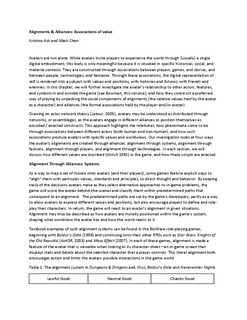Alignments & Alliances: Associations of Value
Abstract
Avatars are not alone. While avatars invite players to experience the world through (usually) a single digital embodiment, this body is only meaningful because it is situated in specific historical, social, and material contexts. They are constructed through associations between players, games, and stories, and between people, technologies, and fantasies. Through these associations, the digital representation of self is rendered into a subject with values and positions, with histories and futures, with friends and enemies. In this chapter, we will further investigate the avatar’s relationship to other actors, features, and symbols in and outside the game (see Bowman, this volume), and how they construct a preferred way of playing by unpacking the social components of alignments (the relative values held by the avatar as a character) and alliances (the formal associations held by the player and/or avatar). Drawing on actor network theory (Latour, 2005), avatars may be understood as distributed through networks, or assemblages, as the avatars engage in different alliances to position themselves as encoded / enacted constructs. This approach highlights the relational; how phenomena come to be through associations between different actors (both human and non-human), and how such associations produce avatars with specific values and worldviews. Our investigation looks at four ways the avatar’s alignments are created through alliances: alignment through systems, alignment through factions, alignment through players, and alignment through technologies. In each section, we will discuss how different values are inscribed (Akrich 1992) in the game, and how these scripts are enacted.
